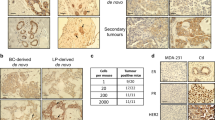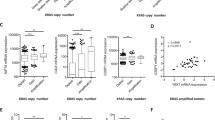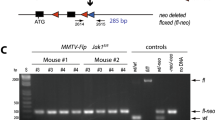Abstract
Int6/eIF3-p48 was first identified as a common integration site for MMTV in mouse mammary tumors. In all cases, the MMTV integration event resulted in an interruption of the normal Int6 transcript from one allele leaving the second allele intact and operative. We hypothesize that insertion of MMTV into Int6 results in a mutated allele that encodes a shortened Int6 mRNA and protein (Int6sh), which either modifies normal Int6 function or possesses a new independent function. To confirm the transforming potential of the mutation and its dominant function, we transfected two mammary epithelial cell lines, MCF10A (human), and HC11 (mouse), with Int6sh under the control of the elongation factor-1α (eEF1A) promoter. Expression of Int6sh in MCF10A and HC11 mammary epithelial cells leads to anchorage-independent growth in soft agar indicative of a transformed phenotype. Colonies selected from agar exhibited high levels of mutated Int6sh and wild type Int6 RNA transcripts by RT–PCR and Northern blot analysis. In addition, Int6sh transformed MCF10A and HC11 cells formed nodular growths, in vivo, in immune compromised hosts. NIH3T3 cells, mouse embryo fibroblasts, were also transformed to anchorage-independent growth in vitro by Int6sh expression. These observations provide direct evidence that the Int6 mutations observed in MMTV-induced tumors and hyperplasia contribute to the malignant transformation of the mammary epithelial cells.
This is a preview of subscription content, access via your institution
Access options
Subscribe to this journal
Receive 50 print issues and online access
$259.00 per year
only $5.18 per issue
Buy this article
- Purchase on Springer Link
- Instant access to full article PDF
Prices may be subject to local taxes which are calculated during checkout







Similar content being viewed by others
References
Aravind L, Ponting CP . 1998 Protein Sci. 7: 1250–1254
Asano K, Krishnamoorthy T, Phan L, Pavitt GD, Hinnebusch AG . 1999 EMBO J. 18: 1673–1688
Asano K, Merrick WC, Hershey JWB . 1997a J. Biol. Chem. 272: 23477–23480
Asano K, Vornlocher H-P, Richter-Cook NJ, Merrick WC, Hinnebusch AG, Hershey JWB . 1997b J. Biol. Chem. 272: 27042–27052
Bandyopadhyay A, Matsumoto T, Maitra U . 2000 Mol. Biol. Cell 11: 4005–4018
Ciardiello F, Gottardis M, Basolo F, Pepe S, Normanno N, Dickson RB, Bianco AR, Salomon DS . 1992 Mol. Carcinog. 6: 43–52
Ciardiello F, McGeady ML, Kim N, Basolo F, Hynes N, Langton BC, Yokozaki H, Saeki T, Elliott JW, Masui H, Mendelsohn J, Soule H, Russo J, Salomon DS . 1990a Cell Growth Differ. 1: 407–420
Ciardiello F, Valverius EM, Colucci-D'Amato GL, Kim N, Bassin RH, Salomon DS . 1990b J. Cell Biochem. 42: 45–57
Crane R, Craig R, Murray R, Dunand-Sauthier I, Humphrey T, Norbury C . 2000 Mol. Biol. Cell. 11: 3993–4003
Desbois C, Rousset R, Bantignies F, Jalinot P . 1996 Science 273: 951–953
Diella F, Levi G, Callahan R . 1997 DNA Cell Biol. 16: 839–847
Fedele M, Berlingieri MT, Scala S, Chiariotti L, Viglietto G, Rippel V, Bullerdiek J, Santoro M, Fusco A . 1998 Oncogene 17: 413–418
Fukuchi-Shimogori T, Ishii I, Kashiwagi K, Mashiba H, Ekimoto H, Igarashi K . 1997 Cancer Res. 57: 5041–5044
Girard L, Jolicoeur P . 1998 Oncogene 16: 517–522
Goldman LA, Cutrone EC, Kotenko SV, Krause CD, Langer JA . 1996 Biotechniques 21: 1013–1015
Grosschedl R, Giese K, Pagel J . 1994 Trends Genet. 10: 94–100
Guo J, Sen GC . 2000 J. Virol. 74: 1892–1899
Hershey JW . 1991 Annu. Rev. Biochem. 60: 717–755
Hofmann K, Bucher P . 1998 Trends Biochem. Sci. 23: 204–205
Jurka J, Milosavljevic A . 1991 J. Mol. Evol. 32: 105–121
Karniol B, Yahalom A, Kwok S, Tsuge T, Matsui M, Deng XW, Chamovitz DA . 1998 FEBS Lett. 439: 173–179
Lazaris-Karatzas A, Montine KS, Sonenberg N . 1990 Nature 345: 544–547
Lazaris-Karatzas A, Sonenberg N . 1992 Mol. Cell. Biol. 12: 1234–1238
MacPherson I, Montagnier L . 1964 Virology 23: 291–294
Marchetti A, Buttitta F, Miyazaki S, Gallahan D, Smith GH, Callahan R . 1995 J. Virol. 69: 1932–1938
Marchetti A, Buttitta F, Pellegrini S, Bertacca G, Callahan R . 2001 Int. J. Oncol. 18: 175–179
Methot N, Song MS, Sonenberg N . 1996 Mol. Cell. Biol. 16: 5328–5334
Miyazaki S, Imatani A, Ballard L, Marchetti A, Buttitta F, Albertsen H, Nevanlinna HA, Gallahan D, Callahan R . 1997 Genomics 46: 155–158
Miyazaki S, Kozak CA, Marchetti A, Buttitta F, Gallahan D, Callahan R . 1995 Genomics 27: 420–424
Mizushima S, Nagata S . 1990 Nucleic Acids. Res. 18: 5322
Neuveut C, Jin D-Y, Semmes OJ, Diella F, Callahan R, Jeang K-T . 1997 J. Biomed. Sci. 4: 229–234
Normanno N, Selvam MP, Qi CF, Saeki T, Johnson G, Kim N, Ciardiello F, Shoyab M, Plowman G, Brandt R, Todaro G, Salomon DS . 1994 Proc. Natl. Acad. Sci. USA 91: 2790–2794
Nupponen NN, Isola J, Visakorpi T . 2000 Genes Chrom. Cancer 28: 203–210
Nupponen NN, Porkka K, Kakkola L, Tanner M, Persson K, Borg A, Isola J, Visakorpi T . 1999 Am. J. Pathol. 154: 1777–1783
Pauley RJ, Soule HD, Tait L, Miller FR, Wolman SR, Dawson PJ, Heppner GH . 1993 Eur. J. Cancer Prev. 2 Suppl 3 67–76
Pestova TV, Hellen CUT, Shatsky IN . 1996 Mol. Cell. Biol. 16: 6859–6869
Sambrook J, Fritsch EF, Maniatis T . 1989 Molecular cloning: a laboratory manual, 2nd edn Cold Spring Harbor Laboratory, Cold Spring Harbor, NY
Soule HD, Maloney TM, Wolman SR, Brenz R, McGrath CM, Russo J, Pauley RJ, Jones RF, Brooks SC . 1990 Cancer Res. 50: 6075–6086
Towbin H, Staehelin T, Gordon J . 1979 Proc. Natl. Acad. Sci. USA 76: 4350–4354
Wei N, Deng XW . 1999 Trends Genet. 15: 98–103
Wen J, Kawamata Y, Tojo H, Tanaka S, Tachi C . 1995 Mol. Reprod. Dev. 41: 399–406
Acknowledgements
We are indebted to Dr Omar Coso for the generous gift of the pCEFLHA vector and Dr Chris Baumann for his tireless work in visualizing the Int6 wild type and Int6sh-GFP fusion proteins. Brenda Jones in Dr D Salomon's laboratory for providing the transformed cell lines for anchorage-independent growth studies. We would also like to thank Dr Mary Hilburger-Ryan and Dr David Salomon for critical reading of this manuscript.
Author information
Authors and Affiliations
Corresponding author
Rights and permissions
About this article
Cite this article
Rasmussen, S., Kordon, E., Callahan, R. et al. Evidence for the transforming activity of a truncated Int6 gene, in vitro. Oncogene 20, 5291–5301 (2001). https://doi.org/10.1038/sj.onc.1204624
Received:
Revised:
Accepted:
Published:
Issue Date:
DOI: https://doi.org/10.1038/sj.onc.1204624
Keywords
This article is cited by
-
Eukaryotic translation initiation factors as promising targets in cancer therapy
Cell Communication and Signaling (2020)
-
Genetic Alterations of Chromosome 8 Genes in Oral Cancer
Scientific Reports (2014)
-
Decreased eIF3e/Int6 expression causes epithelial-to-mesenchymal transition in breast epithelial cells
Oncogene (2013)
-
A novel oncogenic role for the miRNA-506-514 cluster in initiating melanocyte transformation and promoting melanoma growth
Oncogene (2012)
-
Int6 regulates both proteasomal degradation and translation initiation and is critical for proper formation of acini by human mammary epithelium
Oncogene (2011)



